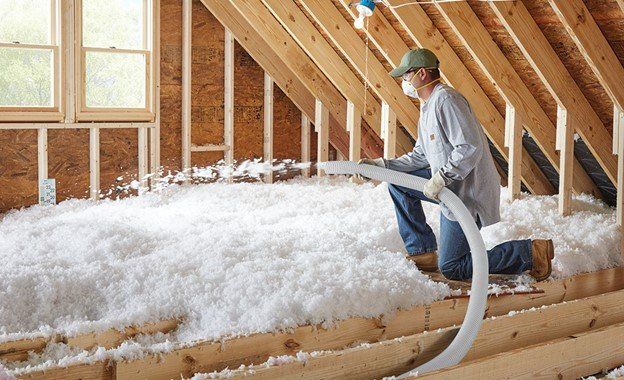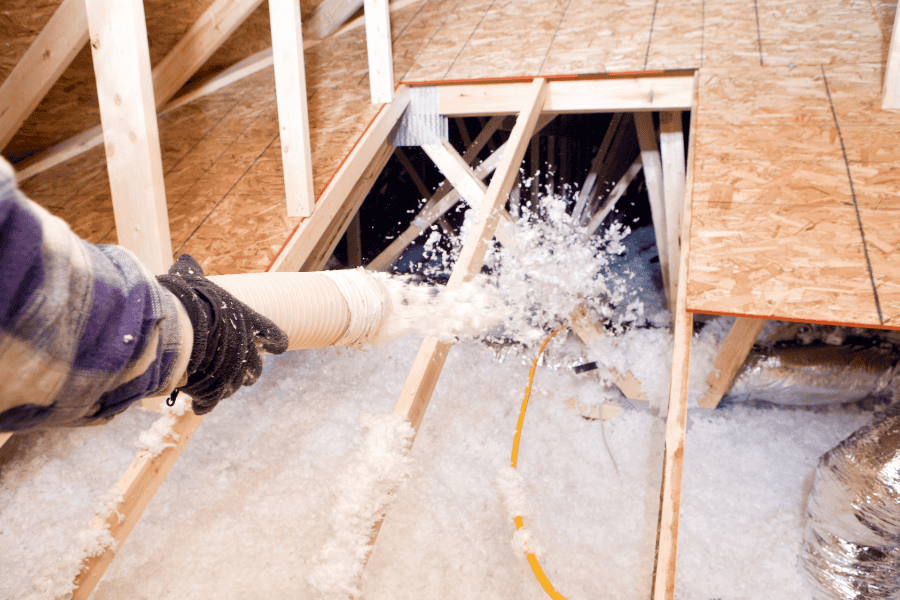Why Blown-In Insulation Performs Best in Gulf Shores, AL’s Wind-Prone Homes
Why Blown-In Insulation Performs Best in Gulf Shores, AL’s Wind-Prone Homes
Blog Article
Blown-in insulation stands out as an optimal choice for homes in Gulf Shores, AL, where high winds and harsh weather conditions are common. Its unique application and superior coverage make it particularly effective in homes that face the constant threat of wind damage. This insulation type not only provides excellent thermal efficiency but also adds a level of air sealing that helps protect homes from the gusty winds that frequent the region.
In this article, we will explore why blown-in insulation outperforms other insulation types in wind-prone areas like Gulf Shores, AL. We'll break down the benefits, technical data, and key considerations for homeowners making the decision to insulate their homes properly against wind-driven conditions.

Types of Insulation for Wind-Prone Homes
Blown-In Insulation vs. Other Insulation Types
Blown-in insulation uses loose-fill material such as cellulose or fiberglass, which is blown into attic spaces, walls, and cavities. This installation method is especially effective in wind-prone homes because of its ability to fill all gaps and spaces, minimizing air leaks.
Here’s a comparison of blown-in insulation versus other common insulation types:
| Insulation Type | Effectiveness in Wind-Prone Areas | Installation Method | Cost | Air Sealing |
| Blown-In Insulation | High: Fills gaps and irregular spaces | Blown into cavities and spaces | Moderate to High | Excellent |
| Spray Foam Insulation | Very High: Expands and seals gaps | Sprayed in place | High | Excellent |
| Fiberglass Batt | Low: Gaps can lead to air leaks | Rolled out between studs | Low to Moderate | Poor |
| Foam Board Insulation | Moderate: Can be sealed around edges | Cut and fitted into spaces | Moderate | Fair |
Why Blown-In Insulation Works Well in Gulf Shores, AL
Blown-in insulation’s ability to seamlessly cover every nook and cranny in a home is its primary advantage. In windy coastal areas like Gulf Shores, the insulation’s coverage ensures that air does not penetrate through cracks, joints, or seams, which is common with batt and foam board insulation. This makes it more effective at maintaining energy efficiency and comfort.
Blown-In Insulation in the Attic
Blown-in insulation is particularly beneficial in attics, where wind-driven rain can lead to moisture infiltration. This material provides a thick, uniform layer that helps to regulate indoor temperatures, reducing energy costs during both hot summers and mild winters in Gulf Shores. It also prevents drafts, contributing to the structural integrity of a home over time.
Things to Consider Before Making a Decision
Before opting for blown-in insulation, homeowners should consider a few factors specific to Gulf Shores, AL, and their unique climate conditions:
1. Local Climate and Weather Patterns
Gulf Shores, known for its coastal environment, faces regular storms, hurricanes, and high winds. These conditions demand an insulation material that can withstand shifting and fluctuating temperatures. Blown-in insulation, due to its adaptability, offers a solid solution.
2. Attic Space and Ventilation
The success of blown-in insulation depends on the condition of the attic. Ensure proper ventilation before installation to avoid trapping excess moisture, which can lead to mold growth.
3. R-Value Requirements
The R-value of an insulation material indicates its thermal resistance. In Gulf Shores, a higher R-value is crucial to maintain consistent indoor temperatures, as well as to protect homes from wind and moisture damage. Blown-in insulation typically offers a high R-value, especially when densely packed.
4. Installation Costs and Budget
Blown-in insulation tends to cost more than fiberglass batt insulation due to the specialized equipment required for installation. However, the long-term energy savings can justify the initial investment.
5. Professional Installation
Proper installation is key to achieving maximum benefits from blown-in insulation. DIY installations may not offer the same level of efficiency and could result in uneven coverage or suboptimal air sealing.
Technical Specifications of Blown-In Insulation
For homeowners considering blown-in insulation, understanding the key specifications is important:
| Specification | Cellulose Blown-In Insulation | Fiberglass Blown-In Insulation |
| R-Value (per inch) | 3.2 - 3.8 | 2.2 - 2.7 |
| Density | 1.5 - 2.0 lbs/ft³ | 1.0 - 1.3 lbs/ft³ |
| Fire Resistance | Good (treated with fire retardants) | Good (naturally fire resistant) |
| Moisture Resistance | Moderate to good (depends on treatment) | Poor (can absorb moisture) |
| Air Barrier | Excellent | Moderate |
Common Questions
Does blown-in insulation improve air quality?
Yes, when installed properly, blown-in insulation can help to minimize drafts and maintain consistent temperatures, improving overall indoor air quality by reducing allergens and moisture.
How long does blown-in insulation last?
Blown-in insulation can last for decades if it is properly maintained and does not experience moisture damage. It is essential to periodically check the attic for signs of moisture infiltration.

- Can I install blown-in insulation myself?
While it’s technically possible to install blown-in insulation yourself, professional installation is recommended to ensure an even application and maximum efficiency. Incorrect installation can lead to air gaps that reduce effectiveness.
- What are the downsides of blown-in insulation?
Blown-in insulation may settle over time, which can reduce its R-value. However, this is typically not an issue if the insulation is regularly checked and topped off as needed.
Bonus Tips
Ensure proper attic ventilation: This will help prevent moisture buildup, which could otherwise degrade the effectiveness of the insulation.
Regularly inspect your insulation: After storms or heavy winds, check for any settling or gaps in your blown-in insulation.
Consider combining insulation types: In some cases, a combination of spray foam and blown-in insulation may offer the best results for energy efficiency and wind resistance.
Frequently Asked Questions (FAQs)
What makes blown-in insulation ideal for wind-prone areas?
Blown-in insulation is ideal for wind-prone areas because it fills every gap and cavity in a home, creating a uniform layer that prevents air leaks. This airtight barrier helps protect the home from wind infiltration, which can drive drafts and moisture inside, reducing energy efficiency and comfort.
- Can blown-in insulation help reduce my energy bills in Gulf Shores?
Yes, blown-in insulation significantly reduces energy costs by improving a home’s thermal performance. It helps maintain consistent indoor temperatures by preventing heat from escaping in the winter and keeping cool air inside during the summer, resulting in lower heating and cooling costs.
- Is blown-in insulation resistant to mold and mildew?
Blown-in insulation, particularly cellulose, is often treated with mold-resistant agents. However, fiberglass blown-in insulation is naturally resistant to mold. It’s important to ensure that the insulation is installed correctly and that there is adequate attic ventilation to prevent moisture buildup, which can lead to mold growth.
- How does the R-value of blown-in insulation compare to other insulation types?
Blown-in insulation generally offers a higher R-value than fiberglass batt insulation, making it more effective at insulating the home. Cellulose blown-in insulation, in particular, has an R-value ranging from 3.2 to 3.8 per inch, which is higher than fiberglass’s R-value of 2.2 to 2.7 per inch.
- How do I know if blown-in insulation is the right choice for my home?
If your home is in a region like Gulf Shores, where high winds and temperature fluctuations are common, blown-in insulation is a good choice. It is particularly effective in attics and hard-to-reach spaces. To determine if it's right for your home, consider factors like attic condition, local climate, and your budget for installation. Consult with a professional for personalized advice.
Conclusion
Blown-in insulation offers significant advantages for homes in Gulf Shores, AL, particularly those located in wind-prone areas. Its superior air sealing capabilities, combined with its ease of installation, make it an ideal choice for maintaining comfort and energy efficiency in coastal environments. Homeowners should consider factors like climate, attic space, and professional installation to maximize the benefits of this insulation type.
Ready to Achieve Superior Comfort and Energy Efficiency?
Evaluate your insulation options carefully based on your home’s specific needs. For guidance and professional installation of blown-in insulation, contact Prestige Insulation Solutions today!
Call us at (850) 429-4969 or email us at [email protected].
Reviewer:
With over 13 years in spray foam insulation, Benjamin Lee reviewed this content and offered feedback aimed at helping growing businesses connect with local homeowners and commercial clients more effectively. Report this page